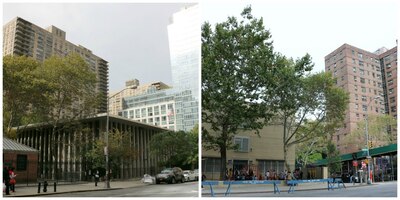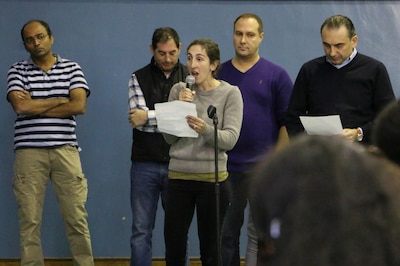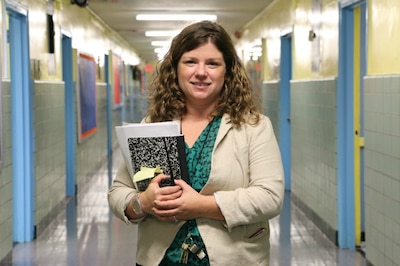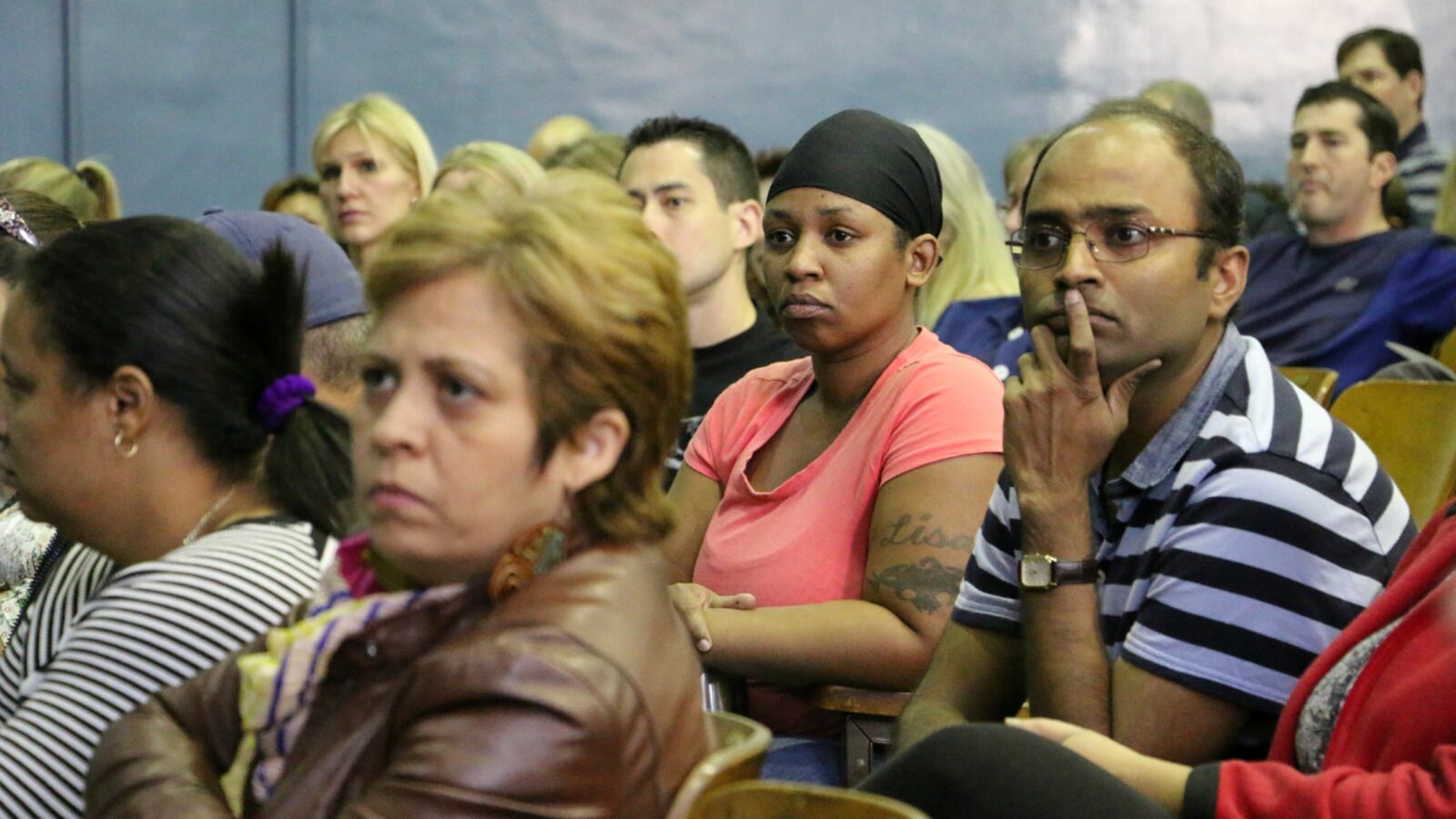The two schools sit nine blocks apart on Manhattan’s Upper West Side, but it’s as if they occupy different universes.
P.S. 199 on West 70th Street is a National Blue Ribbon Award-winner with state test scores twice as high as the city average, whose muscular parent-teacher association raised over $800,000 in the 2014 fiscal year, tax filings show. The majority of its students are white, and just 8 percent qualify as poor.
A short walk south to West 61st Street, P.S. 191 serves mainly students from the public housing across the street. It yields test scores far below the city average, and its parent group raised about $24,000 last year. Most of its students are black or Hispanic, and nearly 90 percent are poor.
The separate-and-unequal worlds of the neighboring schools emerged over many decades. But now, an opening for integration may have appeared.
In order to stem overcrowding at 199, where soaring demand created the city’s longest kindergarten waitlist this year, the city education department has proposed new zone lines that would reroute some would-be 199 students to 191, which has many open seats. In that way, a solution to overcrowding could spur integration.
Some parents want the city to go even further and erase the boundary between the schools. They say a single zone for both schools would end the practice of separate schools for rich and poor, and bring a greater mix of students into each.
“We have an unbelievable opportunity here,” said Noah Gotbaum, a local education council member who has championed that idea, at a recent rezoning meeting.
However, the vast divide between the two schools could undercut either plan. 199 might remain more popular even in a unified zone, and wealthier parents say they might shun 191 even if they were zoned for it.
That was the message at the meeting earlier this month, where parents who said they had settled in the high-priced precinct near Lincoln Center largely because of 199 insisted that 191 — with its low test scores and reports of violence — is an unacceptable alternative.
“If I don’t get into P.S. 199,” said Robert LaSalle, the father of a one-year-old girl, “I’m going to send my kid to private school, or I’m going to move to another district.”
A solution to overcrowding faces a backlash

In a neighborhood where apartments can sell for upwards of $1 million and many parents could afford private school, 199’s academic success has kept local parents clamoring for spots.
To meet the demand, the school has squeezed in at least 150 students more than its building was designed for, leading to full classrooms, jam-packed playgrounds, and traffic gridlock during dismissal. Still, more than 90 families in the school’s zone landed on the kindergarten waitlist this year, prompting some to flee to private schools and others to plead with city officials to find them space at 199.
The city’s solution is to shrink 199’s catchment area and expand those around 191 and P.S. 452, a relatively new school to the north. Education department officials, who will make a final proposal next month, say their plan could increase the share of white students in 191’s zone by nearly a quarter.
But for parents drawn to the pricey neighborhood in part by 199’s prestige, overcrowding is not a sufficient reason to deny them seats — especially when the substitute is 191.
“People would rather have overcrowding at 199 than send their kid to 191,” said Vivian Chen, the parent of a 199 kindergartener whose building would be rezoned for 452. “You don’t move to this kind of neighborhood for that.”
In their own words
Click to hear what local parents and students have to say about the neighborhood’s schools. The blue area is the proposed zone for P.S. 199; the purple area is P.S. 191’s proposed zone.
The situation mirrors one in a gentrifying pocket of Brooklyn, where the city has proposed shifting incoming students from packed P.S. 8 to nearby P.S. 307. But the divide is sharper between the two Manhattan schools and perhaps harder to bridge: Their test-score gap is significantly wider, and the state recently branded P.S. 191 a “persistently dangerous school” based on data from the past two academic years.
Parents and faculty say the designation is misleading. Still, it dealt a crushing blow to the school’s reputation and gave students the legal right to transfer out. Already, the city has had to offer 18 incoming kindergarteners seats at other schools, and 28 current students have applied for transfers, according to an education department spokesman.
Faced with that label and the school’s test scores, some parents who could soon be zoned for 191 have not been swayed by arguments that the school is actually on the upswing. When City Councilwoman Helen Rosenthal spoke during the Oct. 7 hearing about the school’s enthusiastic new principal and extra funding it has received, many parents were skeptical.
“Are the test scores wrong though or are they right?” one man called out. He added, “It’s not just money, it’s parents.”
In interviews, other current and prospective 199 parents repeated the notion that some of 191’s challenges stem from limited parent involvement. One father said that while 199 parents compete to be classroom volunteers, at 191, “nobody cares.” They also worried about sending their children to a school where most of their classmates would be behind academically, at least according to test scores.
Kim Watkins, a member of the district’s education council whose daughter attended 191 until she got into a gifted program at a different school this year, said it would be reasonable to ask would-be 199 parents to take a chance on 191 — if it weren’t for the “incredibly disparate level of student performance” at the two schools.
“You don’t gamble with your kids’ lives like that,” she said.
Despite the public talk about data and designations, some 191 parents and faculty are convinced that part of their neighbors’ wariness about the school stems from the population it serves.
“They think because it’s the projects, it’s bad kids,” said Elizabeth Merced, a 191 parent who lives in the Amsterdam Houses across from the school.
A ‘super zone’ to combat segregation

While the city’s plan to redraw the zoning lines is mainly an effort to curb overcrowding, the shared zone idea put forward by parent leaders has an additional goal: integration.
Families that live within the combined 191-199 “super zone,” as some have called it, could apply to either school. If a school receives more applicants than it has seats, a lottery would go into effect.
Proponents say the plan would open 199 to some students from the housing projects and could send a larger number of affluent students to 191 than a traditional rezoning would. More importantly, they say, it could begin to chip away at the perception that one school belongs to rich families and another belongs to those who are poor.
“A super zone creates equality,” said Seth Rosenthal, who lives in a building whose zoned school would switch from 199 to 191 under the city’s proposal. “Instead of drawing lines, let’s have two great schools.”
Education department planners mapped out a potential shared zone at the request of the District 3 Community Education Council. But the officials have cautioned that such plans have faltered elsewhere when an in-demand school gets flooded with applicants and the less-popular school receives its lottery losers. Some parents share those doubts.
“It’s not going to make 191 more attractive to prospective parents,” said Vildan Altuglu, who lives in 199’s zone, at a rezoning meeting Saturday. “It will not solve the problem.”
Meanwhile, other parents have floated a third plan: pairing the two schools so that students attend one for the early grades and the other for later grades. The schools had such an arrangement decades ago, but it eventually fell apart.
“That was the beginning of the end of diversity,” said Dr. Elena Nasereddin, who was principal of 191 in the 1990s and early 2000s.
City officials have not presented that pairing as an option at the rezoning meetings. In general, Mayor Bill de Blasio — like his predecessor — has been reluctant to make school diversity an overt goal of zoning or admissions-policy changes.
Education department spokeswoman Devora Kaye said creating a diverse school system is an important goal, and that officials consider the impact on school diversity when creating new zones. She said the city would consider all zoning options for 191 and 199, and would work with families at both schools “to ensure the proposal best serves students in the community.”
The district’s community education council, which consists of elected parent leaders, is expected to vote on the city’s final proposal on Nov. 19. If they approve the plan, it would go into effect next school year.
A test ahead, with serious consequences

For now, the plan at 191 is to keep pushing to improve the school, while asking more parents to give it a chance.
Principal Lauren Keville, who is starting her second year at the school, said she has moved swiftly to raise the level of academics by hiring new teacher coaches, installing a new writing curriculum, and instituting a tablet-based reading program. In order to address the behavior incidents, she said she has brought in a new social worker and a school-wide curriculum designed to help students manage their emotions, which has led to a major decrease in incidents this year.
She is also marketing the school to parents. Last Wednesday, she greeted a roomful of prospective parents who had come for the first of many weekly tours the school will give this fall, and at the rezoning meetings she has invited anyone from the community to visit.
“I encourage you to come and see us,” Keville said at one meeting, “so that we can dispel some of the ugly rumors that are out there about our school.”
It remains an open question whether her outreach will convince parents who had counted on sending their children to a high-flying school like 199 to consider one with a tarnished reputation should any new zones be approved. The answer to that question, many believe, could seal the fate of 191 and its students.
“Until we ensure that our schools are both ethnically and economically diverse,” P.S. 191 Assistant Principal Sandra Perez said at Saturday’s hearing, “we will continue to be a school that struggles.”
Additional reporting by Monica Disare. Graphic by Stephanie Snyder and Monica Disare.

